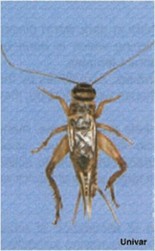Need assistance? Call 800.996.4402
Menu
Need assistance? Call 800.996.4402

House crickets get their common name from the fact that they often enter houses where they can survive indefinitely. Interestingly, they are known for their loud chirping which is caused by rubbing their front wings together to attract females.
House crickets are nocturnal or active at night and usually hide in dark warm places during the day. Outside, they feed on plants and dead or live insects, including other crickets. Indoors, house crickets can feast on fabric, eating large areas, leaving holes and are especially attracted to clothes soiled with perspiration.
Clothing and carpets can become damaged when house crickets enter homes. They typically feed on the surface, leaving the area roughened from pulling the fibers loose while eating.
During warm weather, house crickets typically live outdoors and are especially fond of garbage dumps. They are often attracted to electric lights in larger numbers, sometimes by the thousands, and rest on vertical surfaces such as light poles and house walls. However, when cold weather approaches, they seek shelter in houses and sheds because of the moisture and warmth they provide.
The most effective way to get rid of crickets is to reduce areas of moisture in and around your home. Mow the lawn, weed plant beds and move woodpiles away from the structure. Provide adequate ventilation in crawl spaces, basements, etc. In addition, change outdoor lighting to less-attractive yellow bulbs or sodium vapor lamps. It is also important to seal possible points of entry for house crickets around the house, including window and door frames.






For the very best food safety consulting, auditing and training, please visit our strategic partner, CFS Food Safety